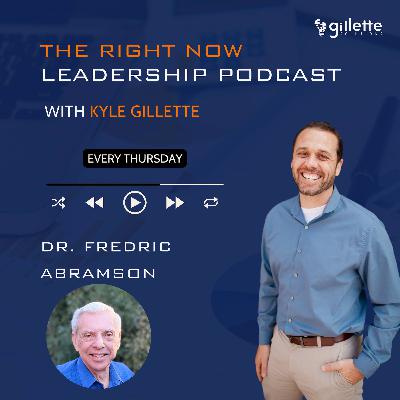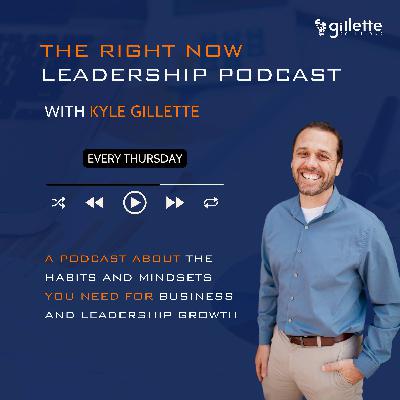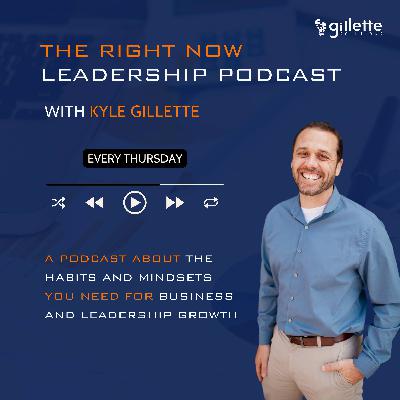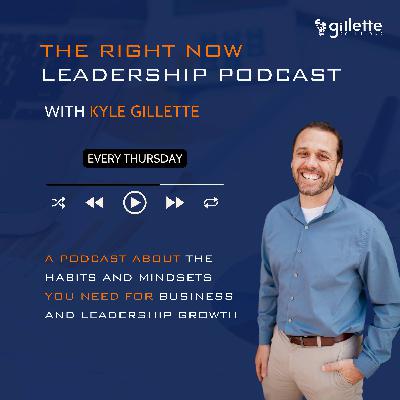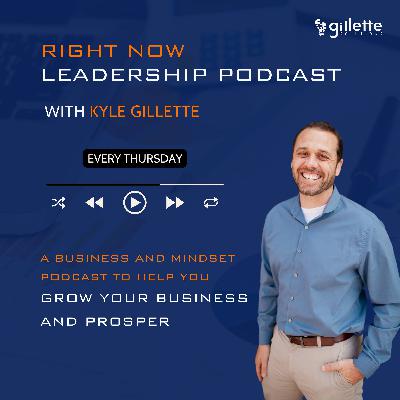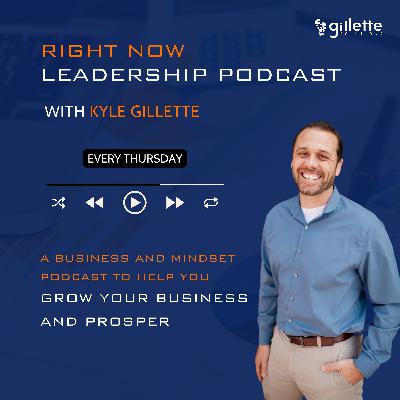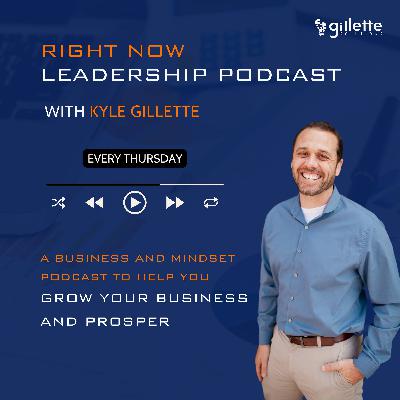Discover Right Now Leadership
Right Now Leadership

21 Episodes
Reverse
Episode Description: In this fascinating episode, we sit down with Dr. Frederick Abramson, a visionary in the intersection of genetics and business leadership. Dr. Abramson delves into how understanding genetic data can revolutionize the way business leaders approach strategy, performance, and success. With a wealth of experience and groundbreaking research, he provides practical insights that can help leaders optimize their potential and drive their organizations forward.
Key Takeaways:
The Connection Between Genetics and Leadership: Dr. Abramson explains how genetic insights can reveal inherent strengths and weaknesses in individuals, allowing leaders to tailor their strategies for better performance.
Practical Applications: Discover real-world examples of how businesses have successfully implemented genetic data to enhance their leadership and operational strategies.
Future Trends: Dr. Abramson shares his predictions on how the field of genetics will continue to impact the business world, offering a glimpse into the future of leadership and organizational development.
Connect with Dr. Abramson on LinkedIn: Fredric Abramson or via email fdabramson@goldenthreadtech.com.
What's the best way to leave a legacy that outlives you? How can we fill the void of fulfillment in our lives, and what does it truly mean to grow personally?
This episode dives deep into the essence of legacy, fulfillment, personal growth, and the profound impact of family and responsibility on shaping our lives. Discover the transformative power of living a purpose-driven life, and how you can unlock your potential to create an indelible impact. Legacy isn't just a concept; it's a journey of resilience, compassion, and leadership.
Following Jeremy Sherrel's personal story of loss and the challenges of parenthood, this video is a testament to the transformative power of love and leadership in crafting a fulfilling and impactful existence. Whether you're seeking guidance on nurturing your family, expanding your personal growth, or making a meaningful contribution to society, this narrative offers insights into overcoming life's hurdles and embracing the strength within.
Embrace the journey towards realizing your God-given potential, and learn how to empower yourself and those around you to excel and thrive. It's about creating a ripple effect of kindness, wisdom, and empowerment that endures across generations.
Join us as we explore how to allow our legacies to live through us, forever changing the world one step at a time. Unlock the secrets to a life filled with purpose, impact, and unconditional love.
Click play to start transforming your tomorrow, today.
Do you have a Mission Statement for your business, life, or parenting? Did you know having one is good for your brain?
Here's the science behind why: A clear mission triggers dopamine, the "feel-good" chemical driving action. It's like a built-in reward system, keeping you motivated.
But that's not all! Mission statements connect you to something bigger, reflecting your values and boosting self-worth. This activates areas linked to belonging – another brainpower bonus!
Think of it as a compass. A good mission statement focuses on your pre-frontal cortex, which is your planning, prioritizing, and decision-making center.In this webinar, I'll cover what makes a mission statement work, why you should have one, and how to create one.
In this episode of the Right Now Leadership Podcast, host Kyle Gillette interviews retired Navy chaplain and author Greg Woodard. They discuss Greg's book "Living the Connected Life: Soul Rhythms for Purposeful Leadership," which is based on his dissertation.
Greg shares his journey of writing, the importance of knowing oneself, and the challenges of pursuing dreams. He talks about overcoming fears, imposter syndrome, and the significance of journaling in personal growth.
Greg offers insights on staying connected to one's passions and the benefits of reflecting through journaling prompts. Listeners are encouraged to reach out to Greg for further dialogue and resources.
Email: greg@gregwoodard.com
Email List: https://page.gregwoodard.com/righnowleadership
Website: www.gregwoodard.com
LinkedIn: https://www.linkedin.com/in/gregory-woodard/
Book a free consultation call: https://tidycal.com/mpo46l3/35-minute-meeting
This episode focuses on the power of celebrating your team's efforts, big or small. Kyle Gillette argues that effective leaders go beyond just rewarding success; they acknowledge the hard work and progress throughout the journey.
Drawing a parallel to a child learning to walk, Kyle emphasizes celebrating the small steps and the dedication behind them. He encourages leaders to practice "Management by Walking Around" (MBWA), actively observing and recognizing incremental improvements within the team.
The episode also highlights the importance of understanding individual preferences for recognition. Kyle suggests open conversations with team members about how they'd like their successes and setbacks to be acknowledged.
I recently had a great call with a client. He was discussing the challenges of traveling for work and staying on routine. Many people face this, myself included.
But there are simple ways to stay disciplined during your travels, both for fun and work. Whether you struggle with sleep, food, exercise, or something else during your trips, this simple process will help you break the pattern. (For many permanently!)
What to do? Don't get mad at me or yourself, but it's pretty simple. Stop it! No, just kidding. Here's what we did to help my client. Discovering the root cause of a negative pattern is key to eliminating it. Whether working with my clients or doing this work on myself, we need to get to the core of it.
Here are three questions to ask yourself. Before I share the questions, this approach works in many areas where our behaviors and mindsets aren't where we want them to be. Just try it.
Okay, the questions.
1. How do you do the problem? You're discovering the pattern of behavior here. Think about this as if someone asks you to describe exactly how you do the problem and map it out for them. Show them the model for this unwanted behavior.
2. How do you not do the problem? When you successfully maintain discipline, even when your routine is broken, how do you do avoid the problem? Once again, act as if someone wants to model your behavior and create a map of how your process works.
3. When was the first time? Ask yourself, when was the first time this problem occurred. Be patient. Wait a few minutes (literally) to get your answer if it doesn't come quickly.
Where were you? Who was there? What were you doing? What did you say to yourself in that experience?
Back to my client's story, we learned a senior told him he should be on the varsity team as a freshman. Then, he also noticed he could keep up or exceed the performance of guys who were working really hard. This is when an unconscious decision was made: "I don't have to work as hard to get great results."
Life changes. This pattern doesn't work in the long run. So, how did this play out? When routine changes, staying disciplined and getting the same results is more challenging, but he told himself a long time ago he could get the results of high performers with less effort.
This is untrue, but the decision created a negative pattern. Breaking the Negative Pattern: What's your challenge?
Whatever it is, go through the three questions above, and once you discover the first time this problem occurred, there's a final question to ask. What is there to learn from this root experience and all other similar experiences from my past?
In other words, you reflect.
Once you have clarity on the lessons to be learned from the root cause of your behavioral pattern, then do the following.
1. The next time you know your routine will be disrupted, visualize the successful completion of how you did it right (item 2 above).
2. Allow yourself to FEEL what it's like to stay disciplined even when the routine is broken. Lock that feeling in like you're sealing Tupperware! These are the steps that I took with my client. They work. This took us just 15 minutes.
Your visualizations can take 30-60 seconds. Everyone has time for that!
A podcast on leadership emphasized fostering a culture of empowerment and accountability. Leaders should be fascinated by those they lead, actively studying their strengths and communication styles. Asking powerful, open-ended questions like "What would success look like?" encourages ownership and problem-solving compared to simple directives.
Trust is crucial.
Micromanaging stifles initiative, while trusting team members to make decisions and learn from mistakes builds accountability. This trust fosters a culture of automatic accountability, where empowered individuals take ownership and report progress. Effective communication is key.
Leaders should be aware of nonverbal cues like body language and tone, ensuring they project an open and encouraging demeanor. Finally, recognizing and celebrating successes, even with small gestures, motivates continued ownership and striving for excellence.
These principles apply to all leadership situations, from work teams to families. By fostering trust, asking powerful questions, and celebrating achievements, leaders can empower others to reach their full potential.
Empowerment is engaging the whole person. Specifically, in this step, we are talking about engaging their unconscious mind. The fastest and simplest way to do this with those you lead is to ask open-ended questions. Questions that require a pause and real thinking.
I recently spoke with a client about her revenue goals for next year. She wants to raise support for her nonprofit and has a 100-200k figure in mind. I immediately heard, “What if you could 10x that number?” So I asked her that exact question. This open-ended question led to a spark of vision and empowerment that set her on an entirely different course about what is possible in her organization. That’s empowerment.
So far, you’ve learned to be fascinated by those you can empower, study them closely, and ask open-ended questions to engage their minds. When you combine all three of these steps, you are on your way to truly empower those you lead. But wait, there’s more.
Now that the people around you get you excited and intrigued about who they are, what they are about, and how they think, you can begin to study them. For example, this looks like observing their behavioral patterns and body language (just not in a creepy way). You can do this through conversations, engaging at meetings, social gatherings, over coffee, etc. The options are boundless.
When I recognized that my middle daughter is a kinesthetic communicator, it really helped me to respect her pace of communication (very slow) and way of communication (with her body and many gestures). This new understanding helped me slow down and respect her model of the world. In turn, helping her to respond better to my requests.
Studying the people around you that you lead and can empower helps you to learn their skills and interests at a different level. When you know their wiring, it is much easier to delegate things to them. It also helps you understand their approach to situations and how you can help them (or get out of the way).
I’ve recently had the privilege of being interviewed on a couple of podcasts (you can find my previous interviews on the Media Page on my website). During the most recent interviews, I was asked how a leader can empower others.
In my book, Right Now Leadership, I share a series of mindsets and habits people can use to empower others, but here I want to share a few layers deeper. You’ll learn about the four practical steps to empowering others. Let’s first define what I mean by empowering others.
In short, engaging their whole person, especially their unconscious mind, to do things that fit who they are and what they are about to their benefit (and, in turn, yours or the organization’s). Before you click away because this seems like it could be a ChatGPT email, it’s not, and I assure you, these steps are different than you’ve heard before.
Start with Fascination
Do you remember the last time you talked to someone and they utterly fascinated you? I mean, you were riveted by their stories, experiences, and who they are (or were). This is the starting point for genuinely empowering others.
Think about the people in your life that you lead and love. Are you fascinated by them? Do you assume they have amazing and interesting stories? Are you intrigued by the way they think and how they solve problems? This can be your spouse, an employee, or your child. When you start with fascination, your unconscious mind engages differently with that person. Just think back to the person who came to mind. How engaged was your body language, your listening, your unconscious mind?
Joining us on the Blue Shirt Leadership Podcast is Chris Michel. Chris is the founder of Coach Chris Consulting and the author of The Red Chair Experience: Daily Inspiration for Success in Life and Business. He helps heal the self-inflicted sales harm that people do to prevent them from being more profitable and successful. Today, he will share a few techniques to overcome sales stumbling blocks and avoid becoming too 'salesy.'
Sales Stumbling Blocks [00:01:09] Chris Michel discusses how people create their own sales objections and how to avoid them by active listening and focusing on benefits rather than features.
Overwhelming Customers with Information [00:02:56] Chris explains how people sabotage themselves by telling customers every little detail about their product or service, overwhelming them with information they don't need.
Adapting to the Customer's Language [00:07:05] He advises on adapting to the language and needs of the customer without becoming "salesy" or "sleazy" by listening and using language that is important to them.
Active Listening and Removing Jargon [00:07:56] Chris emphasizes the importance of active listening and removing technical jargon when communicating with customers to avoid being perceived as "salesy" or "sleazy."
The Red Chair Experience [00:11:47] Chris talks about his book, "The Red Chair Experience," which is a daily inspiration for success in life and business. He encourages readers to find a place to sit and experience life, get inspired, and be motivated on a daily basis.
Contacting Chris Michelle [00:14:31] Contact Chris through his website, coachchrisconsulting.com, where his social media accounts and other information can be found.
#salesstumblingblocks #buildingtrust #smallbusinessowners
Let me start by sharing a quick story. Back in 2018, I began writing a book without a solid plan in place. It was then that I stumbled upon the idea of a 13-week plan, also known as a 90-day plan. This plan involved setting specific targets for the number of words I'd write each day and week, as well as allocating time for writing. The intention was to complete an entire book within this 13-week timeframe.
The Impact of 12-Week GoalsYou might be wondering how this concept of 12-week goals can apply to your own aspirations, whether it's writing a book or achieving any other objective. The answer is simple: Break your goals into 90-day increments and commit to pursuing them intensively during this focused period. The key is to set a clear, achievable goal for each 12-week year.
Benefits of 12-Week GoalsWhy are 12-week goals so effective? For starters, they keep you locked in and focused. They create a sense of urgency and motivation, as each week becomes a critical month in terms of progress. Additionally, you can adjust and refine your approach during the weekly review in the 13th week, making it easier to stay on track.
Applying the 12-Week Goal StrategyLet's apply this strategy to a common example: weight loss. Instead of setting a year-long goal, break it down into 90-day increments. For instance, if you aim to lose 25 pounds, focus on losing 15-17 pounds within the first quarter, knowing that the second quarter will have a different approach. This way, you stay attentive to the specific needs and strategies for each stage.
Visualizing SuccessApart from setting clear 12-week goals, it's essential to visualize what success looks like. When you imagine how achieving your goal will feel, sound, and appear, you engage your unconscious mind in the process. By consistently pursuing the tasks outlined in your 12-week plan and thinking about the outcome, you create a powerful mindset for success.
ConclusionTo sum it up, 12-week goals have a remarkable impact on your ability to achieve more in less time. By setting clear targets and breaking them down into focused 90-day increments, you stay motivated and consistently make progress. Moreover, visualizing your success further enhances your chances of accomplishing your goals. So, take the time to define your 12-week goal and picture what success will look like. Get started today and experience the power of 12-week goals firsthand.
And that's it for today's blog post! If you'd like to dive deeper into the process of goal setting and learn about SMART goals and accountability, I invite you to check out my SMART goals course mentioned in the show notes. Additionally, if you're interested in joining our Blue Shirt community, where you can connect with like-minded individuals and elevate your business and personal life, click on the community link in the show notes. We'd love to have you join us!
To connect with Kyle further, visit his website or the links below.
Check out the Men of Faith in Business Community https://bit.ly/blue-community
Learn more about the SMART Goals Course https://bit.ly/smart-goals-course
Business Growth with Faith & Accountability: Blue Shirt Leadership Podcast Summary
The Blue Shirt Leadership Podcast, hosted by Kyle Gillette, empowers Christian men in business. This condensed summary highlights key takeaways from a recent meeting:
Support & Accountability are Key: Running a business requires support and accountability, especially amid challenges like the COVID-19 pandemic. The speaker shared their struggles and how focusing on mindset and action led to success.
Redefining the CEO: Kyle encourages questioning, "Who's the real CEO?" of your business. It's not just about titles, but about leadership and faith integration.
Partnering with God: The CHO (Chief Heavenly Officer) concept promotes weekly "meetings" with God to reflect, request, and rely on His guidance for business decisions.
Key Questions:
Have you experienced the power of accountability and support?
Who holds the true leadership reins in your business?
Can faith integrate into your business decisions?
Next Steps:
Explore Blue Shirt Coaching resources and the Blue Shirt Community for men of faith in business.
In this podcast episode, Kyle Gillette, the host of the Blue Shirt Leadership Podcast, shares his personal experience with chronic pain and personal discipline, and how it relates to the Blue Shirt Framework for leadership.
Notable Quotes:
"This isn't about changing you, this is about shifting to a better version of you, the one that you're intended to be. That's why self-discipline is so powerful."
"Discipline is the bridge between goals and accomplishment."
Show Notes:
Chronic Pain Story [00:00:50] Kyle shares his experience with chronic pain and how he discovered his food allergies.
Introduction to Blue Shirt Framework [00:04:20] Kyle introduces the Blue Shirt Framework for leadership and explains its four components.
Benefits of Personal Discipline [00:07:46] Kyle discusses the benefits of personal discipline, including becoming more self-aware and being more of oneself.
Be more of yourself [00:08:37] Self-discipline helps you become a better version of yourself, allowing you to do more and deeper work, leading to growth and giving more to others.
Journaling as a personal discipline habit [00:12:14] Journaling creates a third perspective, allowing you to detach from your thoughts and look at them from another person's perspective, making it a powerful habit for self-awareness.
Being coachable [00:16:34] Having coaches or mentors in your life who ask difficult questions and draw out new insights is a habit of self-aware leaders and helps with personal discipline.
Investing in Self [00:17:28] Kyle talks about the importance of investing in oneself and how it has a direct financial impact on one's business.
Accountability Pass [00:19:23] Kyle introduces the Accountability Pass, which consists of four pieces: passive, active, structures, and self. He explains the importance of accountability in achieving one's goals.
Self-Accountability [00:25:12] Kyle discusses the difference between deciding and committing and the importance of self-accountability in achieving one's goals.
Self-commitment and accountability [00:26:08] Kyle discusses the importance of self-commitment and accountability in achieving goals, and provides four steps to increase the likelihood of success.
Growth mindset and taking risks [00:27:23] Kyle introduces the concept of a growth mindset and the importance of taking risks to achieve personal growth.
Studying others for empowerment [00:30:53] Kyle emphasizes the importance of studying people to understand their mindsets, habits, and limitations in order to empower them.
Benefits of Personal Discipline [00:35:00] Kyle discusses the importance of personal discipline and how it can lead to becoming more self-aware and being more of oneself.
Re-emphasizing the Blue Shirt Framework [00:35:36] Kyle reminds listeners of the Blue Shirt Framework for leadership, which stands for being a self-aware leader, leading with accountability, using a growth mindset, and empowering others.
Invitation to Join Blue Shirt Business Community [00:35:36] Kyle invites listeners to join the Blue Shirt Business Community on Facebook and provides instructions on how to do so.
In this episode of the Blue Shirt Leadership Podcast, host Kyle Gillette interviews Todd Miller, a financial expert who helps small businesses build credit. Miller shares his personal experience with business debt and explains how building business credit is crucial for small businesses to achieve financial success. He offers a seven-step process to build business credit, emphasizing the importance of building all three pillars of business credit equally. Miller also notes that building business credit intentionally is necessary and can make a business more credible in the eyes of lenders and government contractors, leading to more opportunities.
Notable Quote:
"Every day that I can rescue a business owner from that happening it's not just affecting them, like I said earlier, it affects their family their employees' families and it builds a stronger community."
Show Notes:
Building Business Credit [00:03:39] Todd Miller explains what business credit is and how it can help small businesses. He also talks about the importance of separating personal assets from business assets.
Steps to Building Business Credit [00:05:09] Todd outlines the seven-step process his company uses to help small businesses build credit. He emphasizes the importance of building credibility and registering with all three business credit bureaus.
Benefits of Business Credit [00:06:18] Todd discusses the freedom that comes with having built up business credit. He explains how businesses can leverage credit to grow and scale without risking personal assets.
Building Business Credit [00:09:13] He explains the importance of building business credit and how most business owners are not utilizing their credit cards to build business credit.
Additional Benefits of Business Credit [00:10:21] Todd Miller discusses how building business credit can make a business look credible to banks and increase its chances of getting approved for loans.
Industries Struggling with Business Credit [00:13:31] Todd Miller talks about how even service businesses that don't require a lot of equipment can benefit from building business credit and how he initially thought only certain industries would struggle with it.
Connect with Todd to learn more about business credit and how you can create more financial stability within your own business. Find him on LinkedIn, on his website, or on Instagram.
Today's episode of The BLUE Shirt Leadership Podcast features Thad Frye, a licensed clinical social worker and certified brain spotting consultant who specializes in a somatic modality called brain spotting. Thad explains how brain spotting works and its benefits, and shares some stories of clients who have benefited from it. He talks about how brain spotting can help people overcome blocks in their personal and professional lives. I think you'll really enjoy today's episode.
Notable Quotes:
"And so you're not gonna be tracking, you're just gonna be following whatever you're feeling in your body, whatever memory you're with, whatever emotion you're feeling. And I kind of hold space for that, that that's my job. Your job is just to go wherever your body and your brain is taking you."
"So again, I would say the biggest part would be to do some kind of work that allows us to access that subcortical brain."
Show Notes:
Introduction [00:00:01] Kyle introduces Thad Frye and explains that he will be discussing brain spotting, a psychological modality that can be used to work with anxiety, trauma, and high performers such as athletes and business people.
Explanation of Brain Spotting [00:01:47] Thad explains that brain spotting is a psychological modality that involves a fixed eye position and noticing where in the body a person feels any kind of charge. It allows therapists to work with the midbrain, which is often called the subconscious or subcortical brain.
Benefits of Brain Spotting and Self-Spotting [00:04:56] He explains that the benefits of brain spotting can come in many different ways, including helping people with anxiety, depression, and PTSD. He also explains that people can do self-spotting and teaches performers and athletes how to do it.
Working with athletes [00:08:53] Thad shares a story of how he helped an athlete overcome past sports-related traumas and injuries to become a top 50 person being recruited in the MLB.
Benefits of brain spotting [00:10:27] Thad explains the benefits of brain spotting and how it can help access the subcortical brain to work through past events that may be causing blocks or panic attacks.
Overcoming resistance to brain spotting [00:12:28] He addresses the resistance some people may have towards brain spotting and shares his own experience of initially being skeptical about it. He encourages people to be curious and open-minded about trying it out.
Brain Spotting Process [00:17:27] Thad explains the process of brain spotting, where clients follow their body and brain's lead, and he manages the time.
Contacting Thad Fry [00:18:29] He shares his website, thadfrycounseling.com, and the Rocky Mountain Brain Spotting Institute for those interested in learning more or working with him.
Conclusion and Call to Action [00:19:15] Kyle Gillette thanks Thad Frye for being on the show and encourages listeners to click on the links in the show notes to learn more about brain spotting and how it can change lives.
Are you ready to build your personal brand and become a recognized authority in your field? In this episode of the Blue Shirt Leadership podcast, Kyle Gillette sits down with Dylan Vance, a two-time eight-figure founder and business speaker, to discuss the power of personal branding.
Notable Quotes:
"If your 'why' is strong enough and if you believe that it's not gonna be a two-week fix, you're gonna commit to it long term, anything is possible."
"Here's something that can never be taken away from you that has limitless potential and allows you to not just make more money, raise your prices, but also get in a room with the people that are the leaders in every single sector, and that is personal branding."
Show Notes:
00:01:52 Personal Branding: A Discussion on the definition and importance of personal branding in todays business world.
00:04:10 Value of Personal Branding: An Exploration of the value and limitless potential of personal branding in the current era.
00:10:01 Building a Personal Brand: Strategies and steps to build a personal brand, including establishing social proof, defining a clear mission, and collaborating with others.
00:11:02 Overcoming Fear and Imposter Syndrome: Discussion on the two obstacles people face when building a brand: fear of what others will think and imposter syndrome.
00:12:36 Reaching New Audiences: Exploration of the importance of reaching new audiences and the fact that the majority of people who see your content are strangers.
00:14:22 Combining Personal Branding with Business Growth: Tips and suggestions on how to combine personal branding with growing a business and generating revenue.
00:20:00 Video Creation App: Discussion about a video creation app that allows users to write scripts, edit, record, add captions, and save videos for free or at a low cost.
00:20:43 Barrier to Entry and Success: Exploration of the low barrier to entry for sharing ideas and the importance of consistency in achieving success.
00:22:50 Staying Consistent and Getting Results: Advice on staying consistent in content creation and the potential for long-term success if the process is followed consistently.


